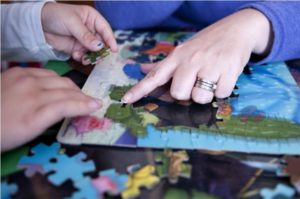Homeschooling is quickly transforming into an enticing option for many parents of special needs children, especially those grappling with sensory issues. With 38% of the 2.5 million homeschooled students in the US with special needs—a rate triple that seen in conventional schools— the National Special Education Advocacy Institute unveils the growing reliance on homeschooling to address anxiety symptoms and focused, customized learning.
However, while weighing the benefits and limitations of homeschooling, one should consider the varied needs of children with needs that often require assistance from experts in their field.

Pros of Homeschooling Children with Sensory Issues:
Customizing a curriculum to fit the individual needs of a child is pivotal. A distinctive learning path is forged by crafting lessons that captivate a child’s interest and address their unique strengths and weaknesses. Integrating diverse elements like music and movement and leveraging innovative teaching approaches are essential steps in customizing education to resonate with every child’s distinct learning style.
Adaptability in scheduling is a cornerstone in crafting a learning environment that minimizes stress and frustrations. This approach allows for modifying lesson durations on challenging days, yielding a serene learning atmosphere. Such flexibility is also instrumental in interweaving other vital obligations, streamlining the integration of medical appointments, therapy sessions, and family commitments into the daily routine.
The empowerment offered by control over social interactions is transformative. It diminishes bullying risks and carves out opportunities for meaningful peer relations on a child’s terms. The emphasis is on nurturing connections through local groups, playdates, and regular get-togethers, fostering an ecosystem of positive and rewarding social interactions.
Crafting a learning space that is both comfortable and sensory-friendly is necessary to mitigate the stimuli overloads often witnessed in conventional schooling environments. These adaptations facilitate a tranquil and accommodating learning sanctuary that resonates with the unique sensory needs of every child.
The essence of learning expands beyond the conventional, embracing daily activities as enriched learning opportunities. Exploration of varied teaching methodologies unveils the strategies that align best with a child, facilitating a diverse and practical learning experience that intertwines creativity and everyday tasks, offering a holistic approach to education.
Creating an Individualized Education Plan (IEP) is also essential, even if it’s not mandatory for homeschooling, as it helps set clear goals, monitor progress, and communicate effectively with specialists.
Cons of Homeschooling Children with Sensory Issues:
The potential pitfalls of homeschooling children with sensory issues often hinge on the lack of consistent daily structure, a component that’s paramount for children who find solace in predictability.
For some children, the structured, regimented environment endemic to traditional schools might be more conducive to their learning and developmental needs, anchoring them in a routine that homeschooled environments might struggle to emulate with the same rigor.
Homeschooling’s detriments also lie in the potential absence of robust resources and facilities typically available in conventional educational settings. The void left by the lack of access to specialized educators, athletic fields, science labs, and full-time medical staff prevalent in public schools can be substantial.
This resource on Sensory Issues offers information that can help mitigate the challenges arising from limited resources in homeschooling settings.
Homeschooling can also delineate the boundaries of peer interaction, potentially impacting the social development of children with sensory issues. This limited exposure to same-age peers curtails opportunities for collaborative learning and mutual growth.
The interaction between neurotypical children and those with disabilities enriches the learning environment, fostering understanding and acceptance, aspects that can be compromised in homeschooling settings.
The multifaceted role of parents in homeschooling scenarios can culminate in exhaustion and burnout, necessitating deliberate self-care and support. The constant juggling between being a parent, teacher, coach, and chauffeur with minimal respite can be a formidable challenge, underscoring the importance of balance and support in navigating the diverse demands of homeschooling children with sensory issues.
Utilizing Resources
Parents should strongly consider networking with local homeschooling organizations and other homeschooling families. Such connections offer support and shared experiences and open avenues for arranging joint field trips and collaborative lessons, adding a multidimensional approach to learning.
You can also leverage a plethora of online resources, curricula, and special needs teaching aids like our Sensory Super page. These resources, many of which are free, can complement and enhance the learning experience for children.
More Opportunities for Learning
Participation in community and after-school activities plays an additional, pivotal role in providing a well-rounded education. Enrolling children in arts, music, drama, sports, or Special Olympics programs can significantly supplement academic learning. Being involved in local groups like Boy Scouts or Girl Scouts ensures the availability of diverse learning experiences and social interaction.
When opting to homeschool a child with sensory issues, there should be meticulous consideration of the child’s distinct needs, family situations, and accessible resources. Maintaining a balance between homeschooling responsibilities and self-care is vital to upholding a conducive teaching-learning atmosphere.
If the challenges presented by homeschooling become unmanageable, exploring alternate educational environments is a prudent step. By focusing on a child’s strengths, establishing a sensory-friendly learning space, and capitalizing on available resources, parents can foster an exciting, effective learning experience at home.




